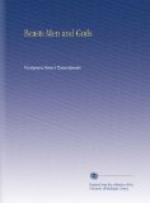The Hutuktu wished us success, presented us with a large yellow hatyk and accompanied us to the monastery gate. When we were in our saddles he said:
“Remember that you are always welcome guests here. Life is very complicated and anything may happen. Perhaps you will be forced in future to re-visit distant Mongolia and then do not miss Narabanchi Kure.”
That night we returned to the Tartars and the next day continued our journey. As I was very tired, the slow, easy motion of the camel was welcome and restful to me. All the day I dozed off at intervals to sleep. It turned out to be very disastrous for me; for, when my camel was going up the steep bank of a river, in one of my naps I fell off and hit my head on a stone, lost consciousness and woke up to find my overcoat covered with blood. My friends surrounded me with their frightened faces. They bandaged my head and we started off again. I only learned long afterwards from a doctor who examined me that I had cracked my skull as the price of my siesta.
We crossed the eastern ranges of the Altai and the Karlik Tag, which are the most oriental sentinels the great Tian Shan system throws out into the regions of the Gobi; and then traversed from the north to the south the entire width of the Khuhu Gobi. Intense cold ruled all this time and fortunately the frozen sands gave us better speed. Before passing the Khara range, we exchanged our rocking-chair steeds for horses, a deal in which the Torguts skinned us badly like the true “old clothes men” they are.
Skirting around these mountains we entered Kansu. It was a dangerous move, for the Chinese were arresting all refugees and I feared for my Russian fellow-travelers. During the days we hid in the ravines, the forests and bushes, making forced marches at night. Four days we thus used in this passage of Kansu. The few Chinese peasants we did encounter were peaceful appearing and most hospitable. A marked sympathetic interest surrounded the Kalmuck, who could speak a bit of Chinese, and my box of medicines. Everywhere we found many ill people, chiefly afflicted with eye troubles, rheumatism and skin diseases.
As we were approaching Nan Shan, the northeast branch of the Altyn Tag (which is in turn the east branch of the Pamir and Karakhorum system), we overhauled a large caravan of Chinese merchants going to Tibet and joined them. For three days we were winding through the endless ravine-like valleys of these mountains and ascending the high passes. But we noticed that the Chinese knew how to pick the easiest routes for caravans over all these difficult places. In a state of semi-consciousness I made this whole journey toward the large group of swampy lakes, feeding the Koko Nor and a whole network of large rivers. From fatigue and constant nervous strain, probably helped by the blow on my head, I began suffering from sharp attacks of chills and fever, burning up at times and then chattering so with my teeth that I frightened my horse who several times threw me from the saddle. I raved, cried out at times and even wept. I called my family and instructed them how they must come to me. I remember as though through a dream how I was taken from the horse by my companions, laid on the ground, supplied with Chinese brandy and, when I recovered a little, how they said to me:




